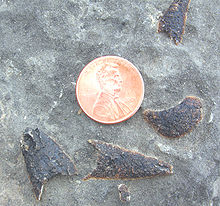| Mattheviidae Temporal range: | |
|---|---|
 | |
| Plates of Matthevia . Coin: 19 mm diameter | |
| Scientific classification | |
| Domain: | Eukaryota |
| Kingdom: | Animalia |
| Phylum: | Mollusca |
| Class: | Polyplacophora |
| Order: | † Paleoloricata |
| Family: | † Mattheviidae Walcott, 1885 |
| Genera | |
| |
Mattheviidae is an extinct taxonomic family of fossil chitons, marine polyplacophoran mollusks that are found in Cambrian-Silurian deposits. [1]